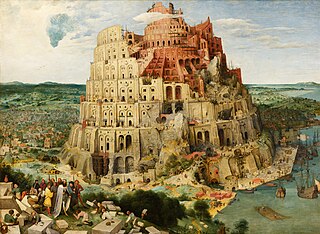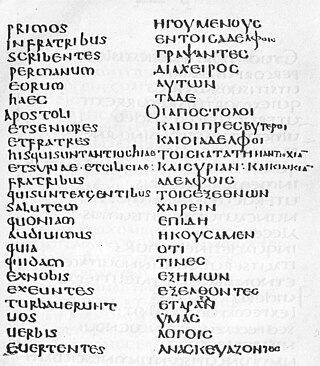
Pieter Bruegelthe Elder was among the most significant artists of Dutch and Flemish Renaissance painting, a painter and printmaker, known for his landscapes and peasant scenes ; he was a pioneer in presenting both types of subject as large paintings.

The Kunsthistorisches Museum Wien is an art museum in Vienna, Austria. Housed in its festive palatial building on the Vienna Ring Road, it is crowned with an octagonal dome. The term Kunsthistorisches Museum applies to both the institution and the main building. It is the largest art museum in the country and one of the most important museums worldwide.

Ananias of Damascus was a disciple of Jesus in Damascus, mentioned in the Acts of the Apostles in the Bible, which describes how he was sent by Jesus to restore the sight of Saul of Tarsus and provide him with additional instruction in the way of the Lord.

The Tower of Babel was the subject of three paintings by Dutch and Flemish Renaissance painter Pieter Bruegel the Elder. The first, a miniature painted on ivory, was painted in 1552–1553 while Bruegel was in Rome, and is now lost. The two surviving works are oil paintings on wood panels, sometimes distinguished by the prefix "Great" and "Little" and by their present location: Kunsthistorisches Museum Wien in Vienna and the latter in the Museum Boijmans Van Beuningen in Rotterdam. The Tower of Babel in Vienna is dated 1563, while the version is Rotterdam is undated but widely believed to have been painted sometime after.

The Peasant Wedding is a 1567 genre painting by the Dutch and Flemish Renaissance painter and printmaker Pieter Bruegel the Elder, one of his many depicting peasant life. It is now in the Kunsthistorisches Museum, Vienna. Pieter Bruegel the Elder enjoyed painting peasants and different aspects of their lives in so many of his paintings that he has been called Peasant-Bruegel, but he was an intellectual, and many of his paintings have a symbolic meaning as well as a moral aspect.

The conversion of Paul the Apostle was, according to the New Testament, an event in the life of Saul/Paul the Apostle that led him to cease persecuting early Christians and to become a follower of Jesus.

Marten van Cleve the Elder was a Flemish painter and draftsman active in Antwerp between 1551 and 1581. Van Cleve is mainly known for his genre scenes with peasants and landscapes, which show a certain resemblance with the work of Pieter Bruegel the Elder. Marten van Cleve was one of the leading Flemish artists of his generation. His subjects and compositions were an important influence on the work of Pieter Brueghel the Younger and other genre painters of his generation.

The Blind Leading the Blind, Blind, or The Parable of the Blind is a painting by the Netherlandish Renaissance artist Pieter Bruegel the Elder, completed in 1568. Executed in distemper on linen canvas, it measures 86 cm × 154 cm. It depicts the Biblical parable of the blind leading the blind from the Gospel of Matthew 15:14, and is in the collection of the Museo di Capodimonte in Naples, Italy.

The Digby Conversion of Saint Paul is a Middle English miracle play of the late fifteenth century. Written in rhyme royal, it is about the conversion of Paul the Apostle. It is part of a collection of mystery plays that was bequeathed to the Bodleian Library by Sir Kenelm Digby in 1634.

The Mill and the Cross is a 2011 drama film directed by Lech Majewski and starring Rutger Hauer, Charlotte Rampling, and Michael York. It is inspired by Pieter Bruegel the Elder's 1564 painting The Procession to Calvary, and based on Michael Francis Gibson's 1996 book The Mill and the Cross. The film was a Polish-Swedish co-production. Filming on the project wrapped in August 2009. It premiered at the Sundance Film Festival on January 23, 2011.

Peeter Baltens, Pieter Balten or Pieter Custodis, was a Flemish Renaissance painter, draughtsman, engraver and publisher. Baltens was also active as an art dealer and poet. He was known for his genre paintings, religious compositions and landscapes.

The Peasant Dance is an oil-on-panel by the Netherlandish Renaissance artist Pieter Bruegel the Elder, painted in circa 1567. It was looted by Napoleon Bonaparte and brought to Paris in 1808, being returned in 1815. In is now in the Kunsthistorisches Museum in Vienna.

The Procession to Calvary is an oil-on-panel by the Netherlandish Renaissance artist Pieter Bruegel the Elder of Christ carrying the Cross set in a large landscape, painted in 1564. It is in the Kunsthistorisches Museum in Vienna.

The Census at Bethlehem is an oil-on-panel painting by the Flemish Renaissance artist Pieter Bruegel the Elder, painted in 1566. It is signed and measures about 1155 × 1645 mm. It is now in the Oldmasters Museum in Brussels, which acquired it in 1902.

The Suicide of Saul is an oil-on-panel painting by the Flemish Renaissance artist Pieter Bruegel the Elder, painted in 1562. It is in the collection of the Kunsthistorisches Museum, in Vienna.
The Conversion of Paul the Apostle is an event in the life of Paul the Apostle.

Acts 8 is the eighth chapter of the Acts of the Apostles in the New Testament of the Christian Bible. It records the burial of Stephen, the beginnings of Christian persecution, the spread of the Gospel of Jesus Christ to the people of Samaria and the conversion of an Ethiopian official. The book containing this chapter is anonymous, but early Christian tradition uniformly affirmed that Luke composed this book as well as the Gospel of Luke. Parts of this chapter may have been drawn from an earlier "Philip cycle of stories" used by Luke in assembling his material.

Acts 9 is the ninth chapter of the Acts of the Apostles in the New Testament of the Christian Bible. It records Saul's conversion and the works of Saint Peter. The book containing this chapter is anonymous but early Christian tradition uniformly affirmed that Luke composed this book as well as the Gospel of Luke.

Several oil-on-oak-panel versions of The Massacre of the Innocents were painted by 16th-century Netherlandish painters Pieter Bruegel the Elder and his son Pieter Brueghel the Younger. The work translates the Biblical account of the Massacre of the Innocents into a winter scene in the Southern Netherlands in the prelude to the Dutch Revolt against Spanish rule, also known as the Eighty Years' War.

The Adoration of the Magi in the Snow is a painting in oils on oak panel of 1563, by Pieter Bruegel the Elder, now in the Oskar Reinhart Collection Am Römerholz in Winterthur, Switzerland. With two Italian exceptions, it is thought to be the first depiction of falling snow in a Western painting, the snowflakes boldly shown by dots of white across the whole scene, added when the work was otherwise completed.






















